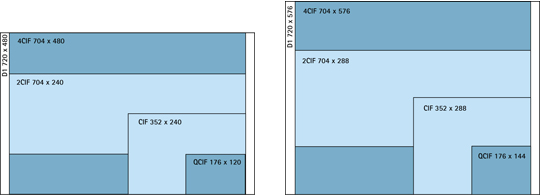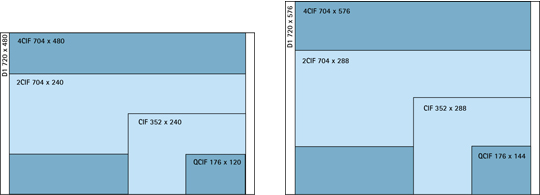Resolution Based CCTV Cameras

Resolution in an analog or digital world is similar, but there are some important differences in how it is defined. In analog video, an image consists of lines or TV-lines since analog video technology is derived from the television industry. In a digital system, an image is made up of square pixels.
NTSC and PAL resolutions
NTSC (National Television System Committee) and PAL (Phase Alternating Line) resolutions are analog video standards. They are relevant to network video since video encoders provide such resolutions when they digitize signals from analog cameras. Current PTZ network cameras and PTZ dome network cameras also provide NTSC and PAL resolutions since such cameras today use a camera block (which incorporates the camera, zoom, auto-focus and auto-iris functions) made for analog video cameras, in conjunction with a built-in video encoder board.
In North America and Japan, the NTSC standard is the predominant analog video standard, while in Europe and many Asian and African countries, the PAL standard is used. Both standards originate from the television industry. NTSC has a resolution of 480 lines and uses a refresh rate of 60 interlaced fields per second (or 30 full frames per second). A new naming convention, which defines the number of lines, type of scan and refresh rate, for this standard is 480i60 (“i” stands for interlaced scanning). PAL has a resolution with 576 lines and uses a refresh rate of 50 interlaced fields per second (or 25 full frames per second). The new naming convention for this standard is 576i50. The total amount of information per second is the same in both standards.
When analog video is digitized, the maximum amount of pixels that can be created is based on the number of TV lines available to be digitized. The maximum size of a digitized image is typically D1 and the most commonly used resolution is 4CIF.
When shown on a computer screen, digitized analog video may show interlacing effects such as tearing and shapes may be off slightly since the pixels generated may not conform to the square pixels on the computer screen. Interlacing effects can be reduced using deinterlacing techniques, while aspect ratio correction can be applied to video before it is displayed to ensure, for instance, that a circle in an analog video remains a circle when shown on a computer screen.


Different NTSC image resolutions Different PAL image resolutions.
VGA resolutions
With 100% digital systems based on network cameras, resolutions that are derived from the computer industry and that are standardized worldwide can be provided, allowing for better flexibility. The limitations of NTSC and PAL become irrelevant.
VGA (Video Graphics Array) is a graphics display system for PCs originally developed by IBM. The resolution is defined as 640x480 pixels, which is a common format used by non-megapixel network cameras. The VGA resolution is normally better suited for network cameras since VGAbased video produces square pixels that match with those on computer screens. Computer monitors can handle resolutions in VGA or multiples of VGA.
| Display Format | Pixels | ||
| QVGA (SIF) | 320x240 | ||
| VGA | 640x480 | ||
| SVGA | 800x600 | ||
| XVGA | 1024x768 | ||
| 4xVGA | 1280x960 |
Megapixel resolutions
A network camera that offers megapixel resolution uses a megapixel sensor to deliver an image that contains one million or more pixels. The more pixels a sensor has, the greater the potential it has for capturing finer details and for producing a higher quality image. Megapixel network cameras can be used to allow users to see more details (ideal for identification of people and objects) or to view a larger area of a scene. This benefit is an important consideration in video surveillance applications.
| Display Format | No.of.Pixels | Pixels | |||
| SXGA | 1.3 megapixels | 1280x1024 | |||
| SXGA+(EXGA) | 1.4 megapixels | 1400x1050 | |||
| UXGA | 1.9 megapixels | 1600x1200 | |||
| WUXGA | 2.3 megapixels | 1920x1200 | |||
| QXGA | 3.1 megapixels | 2048x1536 | |||
| WQXGA | 4.1 megapixels | 2560x1600 | |||
| QSXGA | 5.2 megapixels | 2560x2048 |
Megapixel resolution is one area in which network cameras excel over analog cameras. The maximum resolution a conventional analog camera can provide after the video signal has been digitized in a digital video recorder or a video encoder is D1, which is 720x480 pixels (NTSC) or 720x576 pixels (PAL). The D1 resolution corresponds to a maximum of 414,720 pixels or 0.4 megapixel. By comparison, a common megapixel format of 1280x1024 pixels gives a 1.3-megapixel resolution. This is more than 3 times the resolution that can be provided by analog CCTV cameras. Network cameras with 2-megapixel and 3-megapixel resolutions are also available, and even higher resolutions are expected in the future.
Megapixel resolution also provides a greater degree of flexibility in terms of being able to provide images with different aspect ratios. (Aspect ratio is the ratio of the width of an image to its height.) A conventional TV monitor displays an image with an aspect ratio of 4:3. Axis megapixel network cameras can offer the same ratio, in addition to others, such as 16:9. The advantage of a 16:9 aspect ratio is that unimportant details, usually located in the upper and lower part of a conventional-sized image, are not present and therefore, bandwidth and storage requirements can be reduced.
High-definition television (HDTV) resolutions
HDTV provides up to five times higher resolution than standard analog TV. HDTV also has better color fidelity and a 16:9 format. Defined by SMPTE (Society of Motion Picture and Television Engineers), the two most important HDTV standards are SMPTE 296M and SMPTE 274M.
SMPTE 296M (HDTV 720P) defines a resolution of 1280x720 pixels with high color fidelity in a 16:9 format using progressive scanning at 25/30 Hertz (Hz), which corresponds to 25 or 30 frames per second depending on the country, and at 50/60 Hz (50/60 frames per second).
SMPTE 274M (HDTV 1080) defines a resolution of 1920x1080 pixels with high color fidelity in a 16:9 format using either interlaced or progressive scanning at 25/30 Hz and 50/60Hz.
A camera that complies with the SMPTE standards indicates adherence to HDTV quality and should provide all the benefits of HDTV in resolution, color fidelity and frame rate.
The HDTV standard is based on square pixels—similar to computer screens, so HDTV video from network video products can be shown on either HDTV screens or standard computer monitors. With progressive scan HDTV video, no conversion or deinterlacing technique needs to be applied when the video is to be processed by a computer or displayed on a computer screen.
